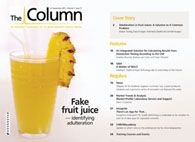Hair today?
Analysis of the hair of ancient Egyptian mummies has found that they used a fat-based ?hair gel? to style their hair. According to researchers this was used as a beauty product during daily life, and during the mummification process where more elaborate styles were created to preserve the deceased?s individuality in death.

Analysis of the hair of ancient Egyptian mummies has found that they used a fat-based ‘hair gel’ to style their hair. According to researchers this was used as a beauty product during daily life, and during the mummification process where more elaborate styles were created to preserve the deceased’s individuality in death.
The study, published in the Journal of Archaeological Science,1 took hair from 18 mummies, both male and female, ranging from 4 to 58 years old when they died. Some were artificially mummified, while others had been preserved naturally by the sand in which they had been buried.
Using light and electron microscopy, the researchers found a fat-like substance coating the hair of nine of the mummies. Gas chromatography coupled with mass spectrometry was used to analyse the substance, which was found to contain biological long-chain fatty acids, including palmitic acid and steraic acid.
This substance was found in both natural and artificial mummies, which the study concludes was used as a beauty product in everyday life, as well as as part of the mummification process. The hair samples did not contain the resins and other embalming materials used to preserve the artificially mummified bodies, so the researchers suggest that the hair had been protected during the embalming process to be treated separately to create more elaborate and individual styles.
1. N.C. McCreeesh, A.P. Gize and A.R. David, J. Archaeol. Sci., (in press).
This story originally appeared in The Column. Click here to view that issue.

Quantifying Inorganic Carbon in Soil Using Sulfamic Acid and Gas Chromatography
May 15th 2025Researchers at Andes Ag, Inc. (Alameda, California) established a high-throughput framework for the robust and precise quantification of soil inorganic carbon (SIC) from agricultural soils using gas chromatography (GC).
Measuring Vitamin K1 Concentrations in Dogs with Chronic Enteropathy Using LC–MS/MS
May 14th 2025A joint study between the University of Tennessee (Knoxville, Tennessee) and the University of Pennsylvania School of Veterinary Medicine (Philadelphia, Pennsylvania) compared directly measured vitamin K1 (vitK1) concentrations in healthy dogs and dogs with chronic enteropathy (CE) using liquid chromatography tandem mass spectrometry (LC–MS/MS); they also investigated whether supplementation of vitK1 in dogs with CE would significantly increase vitK1 concentrations.

.png&w=3840&q=75)

.png&w=3840&q=75)



.png&w=3840&q=75)



.png&w=3840&q=75)












